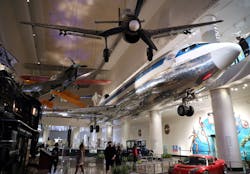Renovated Boeing 727 is Set for Take-Off Again at the MSI. Gone: ‘80s-Era Seats. New: A Vintage Cockpit, Airplane Guts and a Real-Live Black Box.
The Boeing 727 exhibit at the Museum of Science and Industry was a bit of a curiosity before — a striking, expansive silver monument to air travel from below, inside mostly a chance to (hooray!) sit in the well-worn seats of commercial air travel. Window or aisle? Novel to youngsters and those who hadn’t had the chance to travel by air much, but in recent years often passed by.
The wraps came off Thursday from a renovated and expanded “Take Flight” exhibit up on the balcony level in the Hyde Park museum. The plane, a three-engined 727-100 that first saw service with United Airlines in 1964, is still there, but gone are the rows of musty ’80s-era seats with their fold-down tray tables. In their place are displays about aviation facts and history, a vintage cockpit and cutaways and diagrams of how the machine actually works. Or worked.
All that luggage that you knew was, well, somewhere? A glass floor shows that on a flight, it’s about three inches under your feet. There’s a fabled black box and sections showing the 727 aircraft’s insides. Operating landing gear, occasionally lowered by volunteer pilot docents in previous years, now unfolds and retracts every half hour — down on the hall’s main floor it’s mesmerizing. Two screens opposite the plane on the balcony replicate what air traffic controllers see in every movie about jetliners you’ve ever watched; updating in real time like a weather map, it’s a bit of a shock to see the sheer volume of little white fuselages making their way in and out of Chicago at any given moment.
Jessica and Aaron Foutch, of Kenosha, were visiting Thursday with relatives from Kentucky. Aaron, who works for the FAA and knew as much if not more about jet engines as the display and cutaway of the Pratt & Whitney turbofan, said he was suitably impressed. As was son Holden, 8, who liked seeing the landing gear run; he and cousin Alex Oliver, 12, had just come from the flight simulators at the end of the balcony.
“We’re a science-minded family and this is just so cool,” said mother Lindsay Oliver.
Former United pilot Capt. Ken Voelker was on hand in full uniform, mixing with visitors and handing out pilot-wing pins to the youngest. He retired in 2014 and helps organize the team of pilots who occasionally volunteer as tour guides. He said that according to his log books, he had flown this very 727 when it was in service at least a half dozen times.
It was a terrific plane in its day, he said. The front third of the aircraft, including a few rows of seats and the cockpit, has all been restored to how it looked when it first went into service (look for the cocktail tray as a nice “Mad Men” touch).
“The 727 was very responsive,” he said. The controls were all physically linked to the flaps and other part of the aircraft by cable and hydraulics. “It was big but it was like flying a sports car, it was a lot of fun to fly.” Nowadays, fly-by-wire systems mean all those connections are by electronic signals and computers.
United, which donated this aircraft to the museum, used to have more than a hundred 727s in service, he said, it was good for all kinds of airports and short hops and was the most common airliner of its age.
It was also just the right size for the museum, said MSI creative lead John Llewellyn. “Big enough to make an impact but not a 747,” he said.
The aircraft’s (the N7017U and was the 17th 727 built by Boeing) arrival at the MSI in the early 1990s was big news at the time. It landed at Meigs Field, now Northerly Island, in 1992 on a runway certainly not intended for passenger jets. It was taken by barge to Indiana where it was prepared for the exhibit, then by barge again and across Lake Shore Drive into the museum while crowds watched.
If you’ve ever thought the way it hangs over the Transportation Gallery looks precarious, be assured it’s mounted on three steel I-beams that are built into both the balcony and the aircraft. According to Llewellyn, the weight of the airplane is actually less than the weight of the parts of the balcony they had to cut away to make it fit.
The plane still showed cutting-edge aviation when it opened in 1994, Llewellyn said. “A lot of our guests then had never flown themselves before, or some wanted to sit on the plane who had phobias” to flying.
“Plus we just like to have big machines here,” he said.
But over the years, it went from cutting edge to antique. The 1980s interior was worn. “Well-loved,” he said.
The exhibit closed in Oct. 2020 for the renovation project. Along with the cutaways and glass floors, look for displays on air travel and history. Why do your ears pop? Can’t they do anything about turbulence? The fuselage is inscribed with the name of Capt. William Norwood, the first Black pilot for United, and a video interview tells his story.
If nothing else, who knows, maybe you’ll find just sitting in an airliner seat a bit more novel again.
“Take Flight” is included with admission at the Museum of Science and Industry Chicago, 57th St. and Lake Shore Drive; 773-684-1414 and msichicago.org
©2021 Chicago Tribune. Visit chicagotribune.com. Distributed by Tribune Content Agency, LLC.
